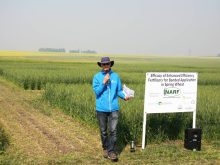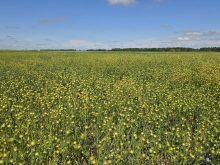SPOKANE, Wash. — Soil borne pathogens are a particularly insidious problem for grain farmers because they are so hard to spot.
Producers can only see the results of an infestation.
“What you can’t see can hurt you,” says Melody Melzer, a researcher at the University of Guelph.
“And sometimes you just have to look a little closer and you will see it.”
Many different kinds of rhizoctonia solani live in the soil, but one strain stands out as a major threat in Western Canada — AG 2-1.
Read Also

Genesis Fertilizers seeks government funding
Genesis Fertilizers is actively seeking funding from government and a strategic partner. The company dispelled a rumour that DL E&C has abandoned the project.
It is especially hard on canola, causing damping off and rot in the seedlings’ pre and post emergent stages.
In lentils and peas, seedlings often need to make several attempts at sprouting to get a shoot above the soil, if they make it at all. This delays emergence and uses up valuable seed resources.
In wheat, the pest causes pre-and post emergent damping off and shows up in outer leaves on newly emerged plants.
“This is a disease problem that you can’t use a crop rotation to deal with. Pulses, canola and cereals are affected,” Melzer said.
Wheat and peas can sometimes be asymptomatic hosts, which means they maintain levels of the disease in the soil until a susceptible crop such as canola is planted. The disease is then ready to reduce plant populations.
Tim Paulitz of the U.S. Department of Agriculture’s research service in Pullman, Washington, said rhizoctonia is on the rise partly because of reduced tillage practices.
However, longterm no-till fields seem to develop pathogen resistance.
He told farmers and crop input dealers attending a recent meeting held by Syngenta in Spokane that the disease is most prevalent in dryland agriculture where less than 300 millimetres of rain typically falls in a season.
“That’s a pretty big area of the West and the Canadian Prairies,” he said.
USDA surveys have found that AG 2-1 is prevalent in North Dakota and Montana, but less so in Minnesota.
AG 8 is most common in Washington state and is often mistaken for wireworm because of the patchiness of wheat fields infected by the pathogenic rhizoctonia.
“The challenge is that farmers see the patches and look to other pests when it’s actually rhizoctonia,” Paulitz said.
Glyphosate may also be compounding the problem.
The herbicide blocks the protective pathways that plants use to keep these diseases at bay. The end result is that large pools of diseased material are continually added to the field.
“This, like most soil borne pathogens, often go unrecognized or are mistaken for nutrient deficiencies,” he said.
Rhizoctonia attack the cell walls of the small root hairs, breaking down tissue and entering the root. Once there, they multiply and eventually kill the root or plant tissue.
Small plants that live past the germination stage start showing signs of nutrient and water deficiency because the roots aren’t available to feed the plant.
Melzer said a survey of farmland in Canada found that the disease is likely under-diagnosed.
It is most prevalent where seeds have been exposed to long periods of damp soil and then to warm, dry periods. Both conditions are common to the Prairies.
“The severity of the disease increases with heat, moisture and organic matter,” said Kiran Shetty, who leads Syngenta’s research into seed protection products.
“Legumes like lentils will abort 50 to 70 percent of their pods when there are root disease problems. If a plant doesn’t get the chance to develop its own defenses, it can’t achieve its genetic yield potential. Seed treatment is about getting the plants to that point.”
Paulitz said soil pH had little or no effect on the pest.
Shetty said the disease can reduce canola populations significantly and soybeans by half.
Syngenta announced earlier this month that it is working on worldwide registration of a new fungicidal seed treatment that will control rhizoctonia infections in most crops.
Sedaxane is part of a new class of fungicides called succinate dehydrogenase inhibitors, which affect the respiration of the fungi similar to stobilurins and carboxamindes.
Sedaxane also interferes with the fungi’s ability to generate energy, which prevents it from growing and threatening seedlings and plants.
Shetty said this broad spectrum of activity against pathogenic fungi is not limited to rhizoctonia. It is also effective against cereal smuts and bunts, snow mold and microdochium infections. It is also been found to be effective against several other fungal diseases.
The seed treatment creates a cloud around the seed and rooting zone that prevents the fungi from reaching the seed.
The seed takes in the Sedaxane as it absorbs water and the tissues become systemically protected. The small plant retains this protection as it emerges from the soil and into its first stages of development.
The molecule has limited mobility in the soil, which means it will spread but won’t rinse away in light soil under higher moisture conditions.
Metzler said this is the time when a plant is most vulnerable to infections and when abiotic stress, such as cold, wet soil, is greatest.
Christian Schlatter of Syngenta said the new seed treatment molecule will be combined with existing products for cereals and oilseeds.
For instance, it will be stacked with Dividend XL RTA in cereals and with Helix XTra in canola.
The company intends to use the existing defences against fusarium, pythium and septoria in cereals.
The combination of Sedaxane and Helix XTra in canola provides protection from seed borne blackleg, alternaria and the seedling disease combination of damping off, seedling blight and root rot caused by pythium and fusarium.
Insect protection will come from the stunning effects of the systemic insecticide thiamethoxam, which is a neonicotinoid.
It has been a challenge to put all those products together and ensure they will bind to the seed, remain water based and travel and store well in extreme temperature conditions.
However, Schlatter said the company has worked out those issues.
“We are using a new method of gaining registration,” he said.
“Simultaneously we are dealing with the U.S., Europe, Brazil, Australia and Canada and others.”
The company hopes to have the treatment in place for cereals, canola, sugar beets and soybeans by next spring, with other registrations to follow by 2015.
Few rhizoctonia solani registered fungicides are available for seed treatment in small grains.














